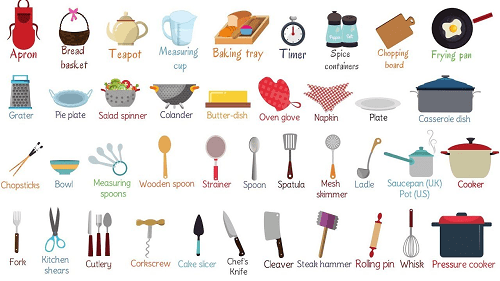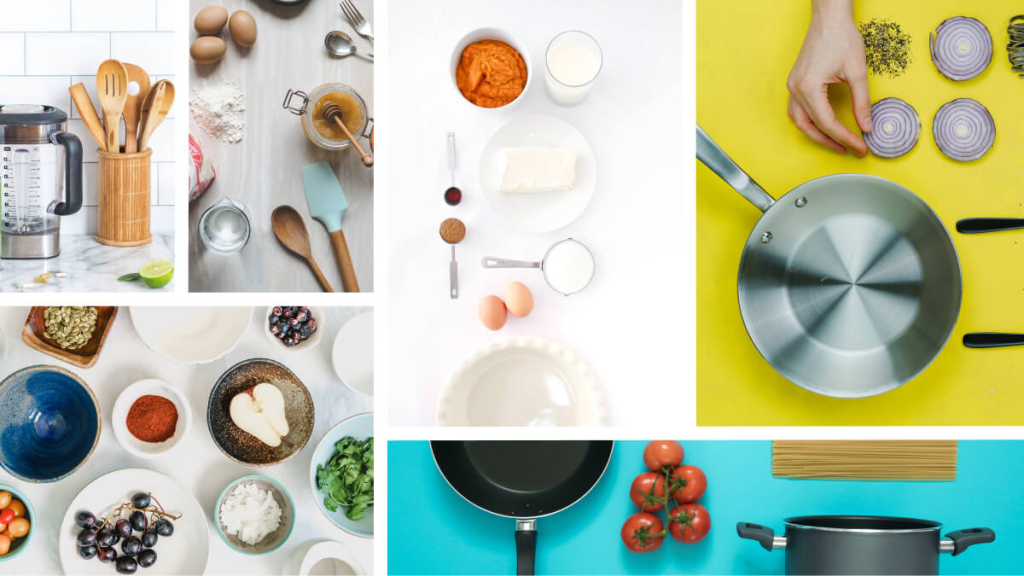Name of the Kitchen Utensils- Here are different types of kitchen utensils categorized by their function:
1. Cutting and Chopping Utensils:
- Chef’s Knife
- Paring Knife
- Bread Knife
- Cleaver
- Cutting Board
- Kitchen Shears
- Mandoline
2. Mixing and Stirring Utensils:
- Whisk
- Wooden Spoon
- Spatula (rubber or silicone)
- Hand Mixer
- Mixing Bowls
3. Measuring Utensils:
- Measuring Cups (for liquids and dry ingredients)
- Measuring Spoons
- Kitchen Scale
4. Cooking Utensils:
- Ladle
- Slotted Spoon
- Tongs
- Spatula (metal or plastic for flipping)
- Skimmer
- Cooking Fork
- Pasta Server
5. Baking Utensils:
- Rolling Pin
- Pastry Brush
- Sifter
- Baking Sheet
- Cooling Rack
- Cookie Cutters
- Dough Scraper
6. Grating and Peeling Utensils:
- Grater (box grater, microplane)
- Peeler (straight or Y-shaped)
- Zester
- Garlic Press
7. Serving Utensils:
- Serving Spoon
- Soup Ladle
- Salad Tongs
- Pie Server
- Ice Cream Scoop
8. Opening and Sealing Utensils:
- Can Opener
- Bottle Opener
- Cork Screw
- Jar Opener
9. Specialty Utensils:
- Pizza Cutter
- Meat Tenderizer
- Potato Masher
- Egg Slicer
- Apple Corer
These categories help organize the types of kitchen utensils based on their uses.
What is Required Name of the Kitchen Utensils
The essential kitchen utensils you need for basic cooking and food preparation include:
1. Cutting and Chopping Tools:
- Chef’s Knife: A versatile knife for chopping, slicing, and dicing.
- Paring Knife: Useful for peeling and precise cutting tasks.
- Cutting Board: A sturdy surface for cutting ingredients.
2. Measuring Tools:
- Measuring Cups: For measuring liquid and dry ingredients.
- Measuring Spoons: For smaller quantities of ingredients.
3. Cooking Utensils:
- Spatula: For flipping, stirring, and scraping.
- Tongs: For grabbing and turning food.
- Ladle: For serving soups or stews.
- Whisk: For mixing and beating.
- Wooden Spoon: A heat-resistant tool for stirring.
4. Pots, Pans and Cooking Surfaces:
- Frying Pan: For sautéing and frying.
- Saucepan: For boiling and simmering.
- Stockpot: For making soups, stocks, or pasta.
5. Miscellaneous Tools:
- Peeler: For peeling fruits and vegetables.
- Grater: For shredding cheese, vegetables, and zesting.
- Can Opener: For opening canned goods.
- Colander: For draining pasta and rinsing vegetables.
6. Mixing and Preparation Tools:
- Mixing Bowls: For mixing and combining ingredients.
- Rolling Pin: For rolling out dough.
7. Serving Utensils:
- Serving Spoon: For serving cooked food.
- Slotted Spoon: For draining and serving food.
These are the basic kitchen utensils that cover most cooking needs, making meal preparation efficient and convenient.
Who is Required Name of the Kitchen Utensils

The term “Who is required” doesn’t quite fit in this context since kitchen utensils are objects, not people. However, if you’re asking who needs kitchen utensils or who typically requires them, the answer would be:
- Home Cooks: Anyone preparing food at home needs essential kitchen utensils for daily cooking tasks.
- Professional Chefs: Chefs in restaurants or catering services rely on specialized utensils to prepare meals efficiently.
- Bakers: People involved in baking require specific utensils like rolling pins, pastry brushes, and dough scrapers.
- Catering Companies: Caterers need a variety of utensils for preparing and serving large quantities of food.
- Cooking Enthusiasts: Hobbyist cooks or those who enjoy trying new recipes often require a wide array of utensils.
- Students or Beginners: Those just starting to cook need a basic set of utensils for simple meal preparation.
- Outdoor Cooks: People cooking at events, camping, or barbecuing outdoors will also require portable kitchen utensils.
Each group needs utensils based on their cooking needs and expertise level.
When is Required Name of the Kitchen Utensils
Kitchen utensils are required at various times depending on the task or situation. Here are some examples of when different kitchen utensils are needed:
1. Cooking Meals:
- Daily Cooking: Utensils like knives, cutting boards, pots, pans, spatulas, and spoons are needed every time you prepare meals.
2. Baking:
- During Baking: Baking-specific utensils like measuring cups, whisks, rolling pins, pastry brushes, and spatulas are required when baking cakes, pastries, or bread.
3. Serving Food:
- Mealtime: Utensils such as serving spoons, ladles, tongs, and salad servers are used when serving food to family or guests.
4. Special Occasions:
- Holidays or Parties: More specialized utensils, like carving knives, pizza cutters, or egg slicers, might be needed for specific dishes or large gatherings.
5. Outdoor or Travel Cooking:
- Camping or BBQs: Portable utensils like tongs, spatulas, and skewers are needed when grilling or cooking outdoors.
6. Food Preparation:
- Prepping Ingredients: When preparing ingredients, utensils like peelers, graters, zesters, and garlic presses are required for peeling, slicing, and seasoning.
7. Cleaning and Storing:
- After Cooking: Tools like colanders for draining and kitchen shears for trimming meat are needed before cleaning or storing food.
These utensils are required at different stages of food preparation, from cooking to serving, depending on the dish or activity at hand.
Where is Required Name of the Kitchen Utensils

Kitchen utensils are required in various places where food preparation, cooking, or serving takes place. Some common locations include:
1. Home Kitchens:
- Primary Location: Kitchen utensils are essential for everyday cooking, meal prep, and baking in homes.
2. Restaurants and Commercial Kitchens:
- Professional Use: Restaurants, hotels, and catering services require a wide range of specialized kitchen utensils for preparing meals efficiently.
3. Bakeries:
- Baking-Specific Tools: Utensils like pastry brushes, rolling pins, and dough scrapers are used in bakeries for creating baked goods.
4. Cafeterias and Dining Halls:
- Large-Scale Food Prep: Cafeterias in schools, hospitals, and workplaces require utensils for cooking and serving large quantities of food.
5. Outdoor Cooking Areas:
- Barbecues and Camping: Utensils like grilling tongs, skewers, and portable spatulas are necessary when cooking outdoors at BBQs, campsites, or picnics.
6. Food Trucks and Mobile Kitchens:
- Mobile Cooking: Food trucks or pop-up kitchens also require essential utensils for preparing and serving food on the go.
7. Catering Events:
- On-Site Cooking: Caterers need utensils for on-site meal prep and serving during weddings, corporate events, or parties.
In summary, kitchen utensils are required wherever food is prepared, cooked, or served, whether it’s at home, in professional kitchens, or during outdoor and mobile cooking events.
How is Required Name of the Kitchen Utensils
The phrase “How is required” doesn’t quite apply when referring to kitchen utensils. However, if you’re asking how kitchen utensils are required or used, here’s an explanation of how different utensils are essential for various tasks:
1. Food Preparation:
- Knives: Used for chopping, slicing, and dicing ingredients like vegetables, fruits, and meats.
- Peeler: Helps in peeling vegetables or fruits efficiently.
- Cutting Board: Provides a safe surface for cutting and prevents damage to countertops.
2. Measuring Ingredients:
- Measuring Cups and Spoons: Required for accurately measuring both dry and liquid ingredients in recipes.
- Kitchen Scale: Used for weighing ingredients precisely, especially in baking.
3. Cooking:
- Spatula: Used for flipping, stirring, and scraping food from pans or bowls.
- Tongs: Handy for turning food, such as meat or vegetables, while cooking on the stove or grill.
- Whisk: Helps in mixing ingredients, beating eggs, or making sauces.
- Ladle: Required for serving soups or liquids from deep pots.
- Saucepan or Frying Pan: Essential for cooking ingredients on a stovetop.
4. Baking:
- Rolling Pin: Used to roll out dough for pies, cookies, or pastries.
- Pastry Brush: Used for glazing or brushing oil, butter, or egg wash onto pastries.
- Baking Sheets and Pans: Required to bake cookies, cakes, or roasts.
5. Serving:
- Serving Spoon and Ladle: Used for dishing out cooked food to plates or bowls.
- Slotted Spoon: Helps drain liquids when serving items like vegetables or pasta.
6. Specialty Tasks:
- Grater: Used to shred cheese, zest citrus, or grate vegetables like carrots.
- Garlic Press: Efficiently crushes garlic cloves for cooking.
- Pizza Cutter: Required for cutting through pizza or flatbreads easily.
In essence, kitchen utensils are required based on how they are used in food preparation, cooking, and serving tasks. Each tool has a specific role, helping make these processes easier and more efficient.
Case Study on Name of the Kitchen Utensils
Case Study: The Evolution and Importance of Kitchen Utensils in Modern Cooking
Introduction:
Kitchen utensils have evolved over centuries, becoming indispensable tools in households and commercial kitchens worldwide. They range from basic items like knives and spoons to specialized equipment like zesters and garlic presses. This case study explores the development, types, and significance of kitchen utensils, focusing on their role in enhancing efficiency, safety, and creativity in cooking.
Background:
Historically, kitchen utensils were basic and often multifunctional. Early humans used sharp stones to cut food, and hollowed-out bones or gourds served as scooping tools. As societies advanced, so did the design and purpose of kitchen utensils. The industrial revolution played a crucial role in mass-producing utensils that were previously handmade, allowing for the rise of modern, specialized kitchen tools.
Today, kitchen utensils serve various functions:
- Cutting and Chopping: Knives, peelers, and mandolines are essential for processing ingredients.
- Cooking and Stirring: Tools like spatulas, ladles, and tongs ensure proper handling of food during cooking.
- Measuring and Baking: Measuring cups, rolling pins, and pastry brushes assist in baking, where precision is key.
- Serving: Ladles, serving spoons, and salad tongs are vital for presentation and service.
The Role of Kitchen Utensils in a Professional Kitchen:
In a professional kitchen setting, utensils are carefully selected to ensure efficiency, precision, and safety. For instance, chefs rely on:
- Chef’s Knife: The most versatile tool in the kitchen, used for slicing, dicing, and chopping.
- Whisk: Essential for whipping sauces or incorporating air into ingredients.
- Tongs: Used for safely flipping meat or vegetables without puncturing them, which would release moisture.
In the professional setting, the ergonomics and material of the utensils become critical factors. Stainless steel utensils, for example, are durable and heat-resistant, making them ideal for long-term use in commercial kitchens.
Challenges and Solutions:
Despite the widespread use of kitchen utensils, certain challenges arise, such as:
- Material Safety: The choice of materials (plastic vs. metal) can affect the durability and safety of utensils. In response, high-quality stainless steel or heat-resistant silicone utensils have gained popularity.
- Ergonomics: Poorly designed utensils can lead to discomfort or injury. Modern designs focus on ergonomics to reduce strain on the hands and wrists, ensuring that utensils are comfortable to use for extended periods.
- Environmental Concerns: With growing awareness about sustainability, there has been a shift towards eco-friendly materials like bamboo or biodegradable plastics for kitchen utensils.
Case Study: Utensil Design in Commercial Kitchens
In a Michelin-starred restaurant in New York, kitchen utensils are critical to ensuring smooth workflow and precision in food preparation. Chefs use specialized tools for different sections of the kitchen:
- Pastry Section: Precise tools like dough scrapers, measuring spoons, and offset spatulas are essential for delicate tasks.
- Grill Section: Grill pans, high-heat spatulas, and meat thermometers help maintain food quality during grilling.
To optimize efficiency, the restaurant also adopts technology-driven utensils like thermocouple thermometers, which provide instant temperature readings. These tools help maintain consistency and reduce the margin of error in professional kitchens.
Impact on Home Cooking:
The influence of professional kitchens has trickled down into households, where home cooks are now equipped with a wide array of utensils. Online cooking shows and recipe blogs often emphasize the importance of having the right tools, leading to a boom in the sales of kitchen utensils.
For example:
- Baking Tools: With the rise in home baking during the pandemic, there was a significant increase in the demand for specialized utensils like silicone baking mats and dough mixers.
- Health-Conscious Cooking: As more people shifted towards healthier eating habits, utensils like air fryers, spiralizers (for vegetable noodles), and steamers became household staples.
Conclusion:
Kitchen utensils have transformed from basic tools to highly specialized instruments that enhance cooking efficiency, safety, and creativity. Whether in a professional kitchen or at home, having the right utensils can make a significant difference in the quality of food preparation. As technology and sustainability trends continue to influence their design, kitchen utensils will likely evolve further, shaping the future of culinary arts.
Key Takeaways:
- Historical Evolution: From primitive tools to modern innovations, utensils have continuously adapted to meet the needs of cooks.
- Specialization in Modern Kitchens: Both home and professional kitchens now rely on specialized utensils for different cooking tasks.
- Ergonomics and Material Choice: The design of utensils now emphasizes user comfort, safety, and sustainability.
- Impact on Home Cooks: Professional-grade utensils are now accessible to home cooks, enhancing their culinary experiences.
This case study demonstrates how essential kitchen utensils are to the art of cooking and how they continue to evolve to meet the changing needs of the culinary world.
White paper on Name of the Kitchen Utensils

White Paper: The Role and Evolution of Kitchen Utensils in Modern Cooking
Introduction
The kitchen is the heart of the home and a critical space in professional environments like restaurants and food production facilities. Central to the function of any kitchen are the utensils used to prepare, cook, and serve food. Kitchen utensils, ranging from simple knives and spoons to specialized tools like zesters and garlic presses, have evolved alongside advancements in technology, materials, and culinary techniques.
This white paper explores the significance, development, and future trends of kitchen utensils, focusing on their role in enhancing efficiency, safety, and innovation in food preparation.
1. Defining Kitchen Utensils
Kitchen utensils are tools or devices used for food preparation, cooking, and serving. They serve a wide array of purposes, including cutting, stirring, measuring, and mixing. The versatility and variety of these tools ensure that food can be prepared efficiently and with precision.
Types of Kitchen Utensils
Kitchen utensils can be broadly categorized into the following groups:
- Cutting and Chopping Utensils: Knives, peelers, and graters
- Mixing and Stirring Utensils: Whisks, spatulas, and wooden spoons
- Measuring Utensils: Measuring cups, spoons, and kitchen scales
- Cooking Utensils: Tongs, ladles, and slotted spoons
- Baking Utensils: Rolling pins, pastry brushes, and dough scrapers
- Serving Utensils: Serving spoons, ladles, and salad servers
Each of these tools plays a specific role in preparing food, ensuring that meals are cooked efficiently and served attractively.
2. Evolution of Kitchen Utensils
Kitchen utensils have a rich history, starting with rudimentary tools made from stones, bones, and wood. As human civilization advanced, so did the sophistication of kitchen utensils. Below are key phases in the development of kitchen utensils:
2.1 Early Tools
- Early humans used natural objects like stones for cutting and shells for scooping. These tools laid the foundation for modern utensils.
2.2 Industrial Revolution
- The Industrial Revolution allowed for mass production of kitchen utensils, transitioning from handmade tools to factory-made items made from materials such as iron, steel, and later, aluminum and plastic.
2.3 20th Century and Technological Advancements
- By the 20th century, new materials like silicone and stainless steel became standard in utensil production. The rise of non-stick cookware also influenced the design of utensils to be more compatible with modern pots and pans.
3. Significance of Kitchen Utensils
Kitchen utensils are critical to the culinary process. Below are some key areas where utensils contribute to the kitchen:
3.1 Efficiency
- Proper kitchen utensils allow for faster and more accurate food preparation. A chef’s knife, for example, can chop ingredients more efficiently than a dull or unsuitable tool, while specialized utensils like tongs help in handling hot food without risking burns.
3.2 Precision
- In professional kitchens, precision is essential for maintaining consistency, especially in baking. Measuring spoons, cups, and kitchen scales are fundamental in ensuring the correct quantities of ingredients are used.
3.3 Safety
- The right utensils can prevent accidents in the kitchen. For instance, a well-designed handle on a knife or peeler reduces the risk of slipping and injuries, while heat-resistant utensils like silicone spatulas help in handling hot food without getting burned.
3.4 Sustainability
- As environmental concerns grow, more attention is being paid to the materials used for kitchen utensils. Bamboo, stainless steel, and silicone are now being chosen for their eco-friendliness, durability, and reusability, reducing the need for single-use plastics.
4. Current Trends and Innovations
The kitchen utensil market has seen significant innovation in recent years, driven by advancements in material science, technology, and consumer preferences.
4.1 Material Innovations
- Silicone Utensils: Heat-resistant, flexible, and durable, silicone utensils have become popular for their compatibility with non-stick cookware and ability to withstand high temperatures.
- Sustainable Materials: Eco-friendly materials like bamboo and biodegradable plastics are gaining traction as consumers become more environmentally conscious.
- Antibacterial Surfaces: Certain utensils now incorporate antibacterial materials to maintain hygiene in the kitchen.
4.2 Technology Integration
- Smart Utensils: With the rise of smart home technology, kitchen utensils have not been left behind. Smart thermometers, for instance, provide real-time data on the internal temperature of food, helping ensure food is cooked to safe and desired levels.
- Multifunctional Utensils: Some utensils are designed to serve multiple purposes. For example, a spoon that doubles as a measuring device or a grater with interchangeable blades can streamline the cooking process.
4.3 Ergonomic Design
- Modern kitchen utensils prioritize user comfort, with ergonomic handles and grips that reduce strain during prolonged use. This is particularly important for professional chefs who spend long hours in the kitchen.
5. The Future of Kitchen Utensils
As technology and sustainability continue to drive change in the culinary world, the future of kitchen utensils looks promising. The focus will likely be on creating tools that are:
- More Efficient: Through automation and smart technology, utensils may become even more specialized and efficient, reducing cooking time and minimizing errors.
- Sustainable and Durable: Materials will continue to evolve to meet the demand for eco-friendly and long-lasting utensils.
- Customizable: The advent of 3D printing may allow for customized kitchen tools, designed to fit individual preferences or kitchen setups.
Conclusion
Kitchen utensils are essential tools that have shaped the way we prepare, cook, and serve food. From their humble beginnings as primitive tools to their modern iterations with smart technology and sustainable materials, utensils play an indispensable role in both home and professional kitchens. As consumer preferences and technologies evolve, kitchen utensils will continue to innovate, becoming more efficient, environmentally friendly, and tailored to the needs of future generations.
By understanding their history, functionality, and future potential, we can appreciate the role of kitchen utensils in the ongoing evolution of culinary arts and home cooking.
Key Recommendations for Consumers and Industry Professionals:
- Invest in Quality: Durable, well-made utensils can improve efficiency and safety in the kitchen.
- Choose Sustainable Materials: Opt for utensils made from eco-friendly materials to reduce environmental impact.
- Explore Technological Advancements: Embrace smart kitchen tools to enhance precision and streamline cooking processes.
- Focus on Ergonomics: Choose utensils that are designed for comfort, especially if they will be used frequently or for extended periods.
Industrial Application of Kitchen Utensils
In large-scale food production, catering services, and commercial kitchens, kitchen utensils are essential for ensuring efficiency, hygiene, safety, and consistency in food preparation. The use of industrial-grade kitchen utensils allows companies to meet the demands of high-volume food production, maintain quality control, and adhere to strict health and safety regulations. This paper outlines the key industrial applications of kitchen utensils and their role in foodservice industries.
1. Commercial Kitchens in Restaurants and Hotels
In restaurants and hotels, kitchen utensils must handle a high volume of work, often under time pressure, while maintaining consistency and quality. The most common industrial applications include:
1.1 Food Preparation:
- Knives: Industrial-grade chef’s knives, cleavers, and boning knives are used for cutting, slicing, and deboning large quantities of food quickly and efficiently.
- Mandolines and Food Processors: These tools help to achieve uniform cuts, which is important for presentation and cooking consistency.
- Chopping Boards: Industrial kitchens use heavy-duty cutting boards, often color-coded to prevent cross-contamination between raw meats, vegetables, and cooked foods.
1.2 Cooking:
- Industrial-Sized Utensils: Commercial kitchens use oversized spatulas, ladles, and tongs designed for handling larger portions of food at a time.
- High-Heat Utensils: Silicone or stainless steel utensils are preferred in commercial kitchens as they can withstand the high temperatures used in industrial ovens, fryers, and stovetops.
1.3 Baking and Pastry Preparation:
- Rolling Pins and Pastry Brushes: In bakeries and hotel kitchens, these utensils are essential for large-scale baking. Industrial rolling pins are often larger and made from durable materials like stainless steel or marble.
- Baking Sheets and Pans: In commercial kitchens, heavy-duty, non-stick baking sheets and pans are used to bake in bulk and maintain uniformity in baked goods.
2. Catering Services
Catering companies rely on portable, durable kitchen utensils to prepare, transport, and serve food at various events, from weddings to corporate gatherings.
2.1 Food Transport and Preparation:
- Portable Utensils: Folding knives, compact peelers, and transportable cutting boards are essential for catering teams that need to prepare food on-site.
- Chafing Dish Utensils: Caterers use specialized serving spoons, tongs, and ladles designed to fit within chafing dishes to keep food warm during service.
2.2 Serving:
- Buffet Utensils: Caterers use oversized, heat-resistant serving utensils that allow for easy and hygienic serving of large quantities of food to guests.
- Disposable Utensils: Biodegradable and compostable serving utensils made from eco-friendly materials like bamboo are used in large-scale events to reduce waste.
3. Industrial Food Processing
In the food processing industry, kitchen utensils are integrated into automated systems or used in quality control and food safety processes.
3.1 Cutting and Chopping:
- Mechanical Knives and Slicers: Large-scale industrial slicing machines are used in factories to cut meats, vegetables, and baked goods with precision. These tools help maintain uniformity and increase production speed.
3.2 Measuring and Mixing:
- Industrial Mixers and Whisks: In food processing plants, industrial mixers are used for blending ingredients on a massive scale, such as in bakeries or packaged food production.
- Automated Measurement: Precision measuring utensils are used in quality control to ensure that ingredients meet the required specifications for packaging or further processing.
3.3 Food Safety and Sanitation:
- Sanitary Utensils: Stainless steel utensils are commonly used in food processing environments due to their ease of cleaning and sterilization. These materials are resistant to corrosion and prevent the buildup of harmful bacteria.
4. Mass Catering (Airlines, Hospitals, Schools)
In large-scale catering for airlines, hospitals, or schools, kitchen utensils are necessary for handling the high volume of food preparation required daily.
4.1 High-Volume Food Preparation:
- Portion Control Utensils: Ladles, scoops, and measuring cups are used in institutional kitchens to maintain strict portion control, ensuring consistency in serving sizes across hundreds or thousands of meals.
- Heavy-Duty Utensils: Industrial spoons, spatulas, and cooking forks made from stainless steel or reinforced plastic are used to handle large quantities of food.
4.2 Hygienic Serving and Storage:
- Insulated Utensils: In settings like hospitals or airlines, utensils that can maintain the temperature of food are essential. Heat-retaining ladles and insulated containers are used to keep food warm during distribution.
- Food Storage Utensils: Air-tight and contamination-resistant utensils like storage containers, scoops, and large mixing bowls are vital for safely storing food in large-scale operations.
5. Food Manufacturing and Packaging
In the food manufacturing industry, utensils play a key role in both the preparation and packaging processes.
5.1 Packaging Preparation:
- Precision Utensils: Utensils such as portioners, molds, and specialized cutters are used to prepare food for packaging, ensuring consistent sizes and shapes for packaged goods like cookies, snacks, or frozen meals.
5.2 Assembly Line Use:
- Automated Scoops and Dispensers: In assembly line production, utensils are often incorporated into machines that dispense precise amounts of ingredients, such as sauces or toppings, into pre-packaged containers.
- Heat-Resistant and Food-Safe Utensils: Utensils used in food manufacturing must comply with strict food safety regulations, often being made of materials like stainless steel or food-grade plastic to ensure no contamination.
Conclusion
The industrial application of kitchen utensils is diverse and essential across various food industries, from high-end restaurants to large-scale food manufacturing. These utensils are critical in ensuring efficiency, precision, safety, and hygiene in food preparation, processing, and serving. The design and materials used for industrial kitchen utensils must meet the specific demands of high-volume environments, while also complying with food safety standards.
The ongoing innovation in materials, ergonomic design, and technology will likely continue to enhance the functionality of kitchen utensils, further streamlining industrial food production and improving the quality of foodservice across the board.





